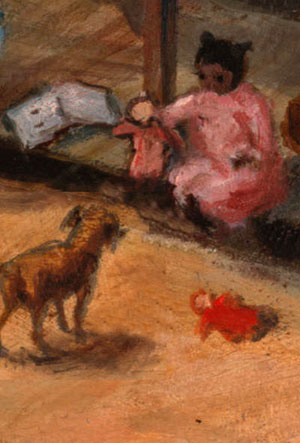
Emma Williams, the baby of the family, sits on the edge of the porch playing with her dolls under the watchful eye of her mother. She loved the evenings on the porch when all her family was gathered nearby, even though her brothers sometimes teased her for including the family dog in her games. A tea party with her dolls—and the dog—was her favorite activity.
In the late 1800's, most children's toys were still made by hand, either by the child or a family member. Store-bought toys were something of a luxury, especially for rural families like the Williams. It is another sign of the family's successful economic situation that a number of fragments from manufactured toys were uncovered at the site.
Whether store-bought or homemade, toys provided a variety of ways to fill the time between schoolwork and chores with fun.
See what the archeologists found!

Ransom and Sarah Williams had a total of nine children while they lived on the farm, so we can imagine that toys were important items to have on hand! Archeologists uncovered a variety of toy parts. Some were rusty, and some were broken into pieces, but with careful study, most of them could be recognized. Among the small pieces of white ceramics are remnants of a doll and doll-sized cups and saucers. There also are several types of marbles, a rubber ball, and even a cap gun.
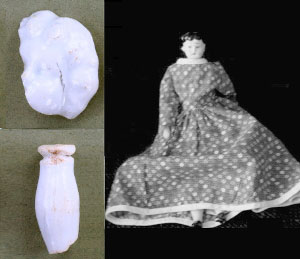
The porcelain doll pieces found at the farn are typical of dolls made in the U.S. and Europe in the late 19th century. Typically, the doll’s head, and sometimes the arms and lower legs, were made of porcelain, papier-mache or a blend of sawdust and glue, and the body was made of leather or fabric. No doubt the Williams’ girls sewed dresses for their dolls, held tea parties and learned about caring for babies, just like girls do today.
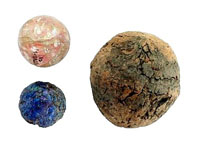
Dolls and other human-like figures have been popular playthings for many thousands of years. Before the mid-1800’s, dolls were made by hand, one at a time. Some were fancy with embroidered faces and button eyes, but most were plain and made from materials that were readily available such as wood, bone, corn husks and scraps of yarn or fabric.
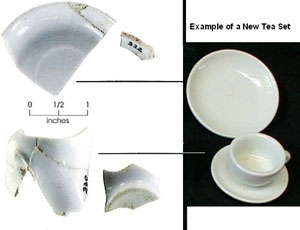
These small fragments of porcelain from a doll’s tea set indicate another store-bought toy the Williams’ children owned. Many companies that made china dishes for the family table also made smaller versions for children. Emma and her sisters probably organized doll parties with their friends, serving imaginary tea and cookies to their “guests.”

Glass marbles and a rubber ball were found at the Williams’ site. Ransom’s sons probably spent some fun times playing marble games with their friends.
Clay marbles, which were made in the 1890s before glass marbles were invented, also were found at the site. Hardened clay balls and rounded stones have been found in Egyptian and Aztec tombs and many Native American sites. Children in many cultures have played a variety of games with similar small round objects. Marbles was a very popular game among American boys from colonial times to the mid-20th century. Often boys made their own marbles out of clay, drying them in the sun until they were hard.
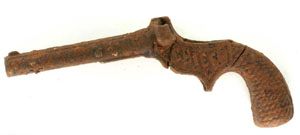
The handle and barrel of a CHIEF cap pistol found at the site is another store-bought toy the Williams’ children owned. It is missing the firing mechanism. The charge was a simple mixture of powdered chemicals in small dots between two layers of paper layers. Gases created by the chemical mixture made a loud sound when the cap was struck. Boys enjoyed imitating their fathers hunting and acting out the exciting cowboy stories in the books they read. Cap guns became even more popular during the 1930’s and 40’s because of the flood of Western movies and stars such as Tom Mix, Roy Rogers and Gene Autry.
